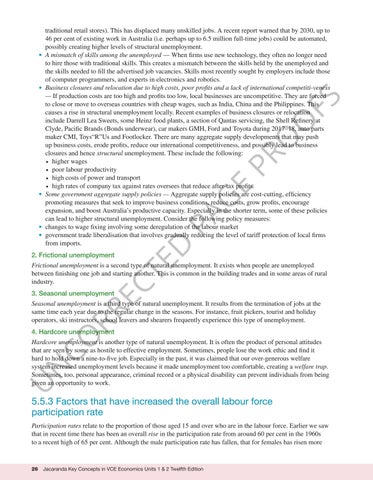“c05TheChangingLabourMarket_PrintPDF” — 2022/6/3 — 13:15 — page 26 — #26
•
G
PA
• •
TE
2. Frictional unemployment
D
•
E
PR
O
O
FS
•
traditional retail stores). This has displaced many unskilled jobs. A recent report warned that by 2030, up to 46 per cent of existing work in Australia (i.e. perhaps up to 6.5 million full-time jobs) could be automated, possibly creating higher levels of structural unemployment. A mismatch of skills among the unemployed — When firms use new technology, they often no longer need to hire those with traditional skills. This creates a mismatch between the skills held by the unemployed and the skills needed to fill the advertised job vacancies. Skills most recently sought by employers include those of computer programmers, and experts in electronics and robotics. Business closures and relocation due to high costs, poor profits and a lack of international competiti-veness — If production costs are too high and profits too low, local businesses are uncompetitive. They are forced to close or move to overseas countries with cheap wages, such as India, China and the Philippines. This causes a rise in structural unemployment locally. Recent examples of business closures or relocation include Darrell Lea Sweets, some Heinz food plants, a section of Qantas servicing, the Shell Refinery at Clyde, Pacific Brands (Bonds underwear), car makers GMH, Ford and Toyota during 2017–18, auto parts maker CMI, Toys“R”Us and Footlocker. There are many aggregate supply developments that may push up business costs, erode profits, reduce our international competitiveness, and possibly lead to business closures and hence structural unemployment. These include the following: • higher wages • poor labour productivity • high costs of power and transport • high rates of company tax against rates oversees that reduce after-tax profits. Some government aggregate supply policies — Aggregate supply policies are cost-cutting, efficiency promoting measures that seek to improve business conditions, reduce costs, grow profits, encourage expansion, and boost Australia’s productive capacity. Especially in the shorter term, some of these policies can lead to higher structural unemployment. Consider the following policy measures: changes to wage fixing involving some deregulation of the labour market government trade liberalisation that involves gradually reducing the level of tariff protection of local firms from imports.
CO RR EC
Frictional unemployment is a second type of natural unemployment. It exists when people are unemployed between finishing one job and starting another. This is common in the building trades and in some areas of rural industry. 3. Seasonal unemployment
Seasonal unemployment is a third type of natural unemployment. It results from the termination of jobs at the same time each year due to the regular change in the seasons. For instance, fruit pickers, tourist and holiday operators, ski instructors, school leavers and shearers frequently experience this type of unemployment. 4. Hardcore unemployment
U
N
Hardcore unemployment is another type of natural unemployment. It is often the product of personal attitudes that are seen by some as hostile to effective employment. Sometimes, people lose the work ethic and find it hard to hold down a nine-to-five job. Especially in the past, it was claimed that our over-generous welfare system increased unemployment levels because it made unemployment too comfortable, creating a welfare trap. Sometimes, too, personal appearance, criminal record or a physical disability can prevent individuals from being given an opportunity to work.
5.5.3 Factors that have increased the overall labour force participation rate Participation rates relate to the proportion of those aged 15 and over who are in the labour force. Earlier we saw that in recent time there has been an overall rise in the participation rate from around 60 per cent in the 1960s to a recent high of 65 per cent. Although the male participation rate has fallen, that for females has risen more
26
Jacaranda Key Concepts in VCE Economics Units 1 & 2 Twelfth Edition





















































